Warner elevator row
| Warner elevator | |
|---|---|
| General information | |
| Architectural style | agriculture |
| Town or city | Warner, Alberta |
| Country | Canada |
| Coordinates | 49°09′48″N 112°03′51″W / 49.1634°N 112.0643°WCoordinates: 49°09′48″N 112°03′51″W / 49.1634°N 112.0643°W |
| Construction started | 1913–1960s |
| Completed | 1960s |
| Demolished |
X.C. Hadford Company (1950–2001) Ogilvie Flour Mills (1929–2000) Ellison Milling & Flour Co. (1939–2000) alberta farmer's co-operative elevator company (1913-2014) Alberta Wheat Pool (1951-2014) Alberta pool elevator (1928-2014) |
| Client |
Current owner(s) Viterra |
| Technical details | |
| Structural system | Wood-crib |
| Design and construction | |
| Architect |
Companies (builders) United Grain Growers X.C. Hadford Company Alberta Farmers Co-operative Elevator Co. Alberta Pacific Grain Co. Federal Grain LTD. Ogilvie Flour Mills Ellison Milling & Flour Co. |
Warner elevator is a row of historic wood-cribbed grain elevators with Three elevators all standing in a row from south to north, alongside the Canadian Pacific Railway, that travels from Great Falls, Montana to Lethbridge, Alberta, on the east entrance of the village of Warner, Alberta, Canada.
History and significance
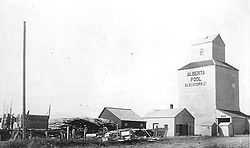
Since a vast number of the once-dominant wood-crib grain elevators throughout Canada have been torn down, only one elevator row have survived partial demolition if not complete demolition. An example of such is Vulcan, Alberta, which once boasted a total of 12 grain elevators at one time, more than any location west of Winnipeg, Manitoba. By 2000 all but one have since been demolished and replaced with two larger concrete grain terminals on the southeast side of town.
Warner now only has Three elevators, the other Inglis elevator row (Inglis, Manitoba), with a total of five elevators. Warner's elevators have not been protected. The elevators at Inglis however have since been fully restored back to their original signage and are now fully protected as National Historic Sites of Canada.
Prior to 1911 Warner had two elevators, one was a 30,000 imperial bushels (1,100 m3) house built by Alberta Pacific Elevator Co., and the other was a 25,000 imperial bushels (910 m3) elevator built by Jones and Dill. In 1913 the first elevator remaining group was constructed by the Alberta Farmers' Co-operative Elevator Co..
The individual structural and narrative history of the elevators illustrates well developments in the grain industry and individual companies from before WWII to the 1980s.
The elevators built at Warner date from 1913 to 1960. The row included an early example of the Alberta Farmers' Co-operative Elevator company design, and an example of several different complex component arrangements; elevator and twin, elevator and annexes of several types, original type offices and replacement offices. The row has a total of two complexes, with a total of three elevators. The elevator built by Ellison Milling and Elevator Co. in 1939 is an architecturally significant example of a 1940s complex that has undergone almost no change, comprising an elevator, two balloon annexes, and a track side office/warehouse, usually associated with an earlier period. There are only a small number of elevators from the later 1930s left standing in the province; a reminder that few were built for some time after 1934. This elevator was demolished in the early 2000s.
The grain elevators
The grain elevators in Warner have a high degree of integrity; few elevators have been removed from the row which is perhaps the most impressive row in Alberta with four complexes (six elevators). The individual elevators, with the exception of the UGG elevator, have had little modification and several have old small scales and air dumps in situ.

Demolitions
Since 1999–2014 a total of Six elevators have been torn down at Warner, bringing the row to a total of Two complexes, with a total of Three elevators.
History
The history of the elevators in the row from north to south, those still standing and those demolished is presented:
United Grain Growers
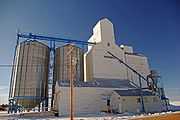
This elevator and accompanying annex was built 1957–1960. It was UGG's second elevator at Warner, the first having been sold to Alberta Pool Elevators in 1928. It was licensed for 134,000 imperial bushels (4,900 m3) in 1960. The elevator has had substantial upgrading in the late 1980s, including the installation of a new leg that has required heightening part of the cupola roof. The metal bin annexes on the south side, complete with drag auger, also date from this time. A cyclone dust collector and truck loading spout have also been installed. A roofed warehouse located track-side on the north side of the elevator, was most likely built at the same time as the elevator.
X.C. Hadford Company (demolished)
This elevator was built by X. C. Hadford Company in 1950. It was licensed as a 15,000-imperial-bushel (550 m3) seed plant in 1952. It is now operated by Demeter Argo, owned by the Alberta Wheat Pool. In 1992 it was licensed as a primary elevator with a capacity of 240 tonnes. It is used to handle mustard seed. No further information on the structural history of the complex has been found. This elevator has been torn down.
Alberta Farmers Co-operative Elevator Company (twin) (Demolished)
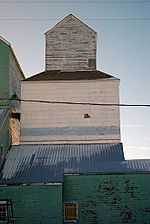
This 35,000-imperial-bushel (1,300 m3) elevator was built in 1913. It measures 31 × 42 × 65 feet (9.4 × 12.8 × 19.8 m). This elevator is one of two oldest extant examples of the standard design used by Alberta Farmers' Elevator Co. 1913–1917. It is built on the standard plan used by the Alberta Farmers Co-operative elevator company. It has a pyramidal roof with a gable roofed cupola housing the head of the leg. Archival photographs of other Alberta Farmers' Co-operative Elevator Co. facilities suggest that this elevator probably originally had an office that sat trackside beside the elevator also served as a warehouse.
_-_Warner.jpg)
In 1913 the UFA proposed the establishment of the Alberta Farmers' Elevator Co. as the solution to producers' problems in Alberta. Shares were issued to farmers at $60 par value, payable in four annual installments. The Alberta government provided financing through a loan for 85% of the share sum. In order to market their grain and guarantee their loans during a time of rapid wartime expansion the Alberta Farmers' Co-operative Elevator Co. relied on the experience of the Grain Growers Grain Co. of Manitoba. In 1917 the two companies amalgamated to form the United Grain Growers, with headquarters Winnipeg.
In 1928 UGG sold their 1913 Warner elevator to Alberta Pool Elevator Co. A coal shed that had been associated with the elevator since 1926 was sold in 1940 and removed from the site. In 1940 a 35,000-imperial-bushel (1,300 m3) balloon annex, built by F. W. McDougall Construction Company, was added to the elevator. It was removed at an unknown date. The elevator was twinned with a new elevator constructed by the Pool in 1951. A new driveway was constructed at this time. The 1913 elevator has a high degree of structural and mechanical integrity. The trackside loading area has not been modified. The metal cladding is original to the structure. The cupola, however, has been reclad with siding.This elevator has been torn down.
Alberta Wheat Pool (twin) (Demolished)
This 60,000-imperial-bushel (2,200 m3) elevator was built in 1951, and subsequently twinned with the 1913 elevator. It measures 38 × 42 × 65 feet (12 × 13 × 20 m). The elevator has a high degree of structural and mechanical integrity and appears much as it did in 1951. The short scale and pneumatic dump are still in place.This elevator has been torn down.
Alberta Pool Elevator Co. (Demolished)
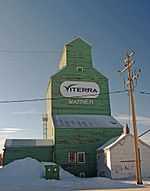
This elevator was built by Voss Bros for Alberta Pool Elevator Co. in 1928. It was built according to the standard 40,000-imperial-bushel (1,500 m3) plan, at a cost of $15,300. It measures 34 × 35 × 62 feet (10 × 11 × 19 m). A balloon annex was built in 1940, on the south side. It was removed in 1995. The elevator has a high degree of structural and mechanical integrity, and is complete with original scale and pneumatic dump. The rear part of the office, now that the engine has been removed, has been converted into a warehouse. This elevator served as AWP's No. 2 elevator in the summer of 1997.This elevator has been torn down.
Alberta Pacific Grain Co. (twin)
_-_Warner.jpg)
This 45,000-imperial-bushel (1,600 m3) elevator was built in 1918 by Alberta Pacific Grain Co. It replaced a pre 1911 Alberta Pacific Elevator Co. It may have had an annex as it was licensed in 1918 for 60,000 imperial bushels (2,200 m3) and for only 45,000 imperial bushels (1,600 m3) in 1922. In 1953 a 23,000-imperial-bushel (840 m3) annex was attached to the north side of the elevator. A second annex was added in 1959. In 1967 the elevator was taken over by Federal Grain Ltd. The next year Federal built a new elevator and twinned it with the 1918 elevator. The 1959 annex was then moved to the south side of the new elevator. A driveway was built the length of both elevators at this time. The 1953 annex was removed in 1997. In 1972 the complex was sold to Alberta Wheat Pool; in the summer of 1997 it served as AWP No. 4 house.
Federal Grain LTD. (twin)
This 65,000-imperial-bushel (2,400 m3) elevator was built by Federal Grain Ltd. In 1968, and twinned with 1918 elevator Federal had taken over the previous year. It measures 38 × 44 × 66 feet (12 × 13 × 20 m). The elevator has no structural upgrading but it does have an electronic scale, and an exterior loading spout for trucks. This elevator was among the last built on the traditional design, before the single composite design came into widespread use.
Ogilvie Flour Mills (demolished)
This 35,000 elevator was built by Ogilvie Flour Mills in 1929. A 30,000-imperial-bushel (1,100 m3) balloon annex was added in 1940, and a second one with 25,000-imperial-bushel (910 m3) capacity in 1952. One of the annexes was removed in 1997. The driveway has been heightened, but despite this is still too low for larger trucks. An auger is used to dump the trucks into the pit. The driveway ramp is very steep. The elevator has a high degree of structural and mechanical integrity. The elevator has an attached office, that appears to be original to the site. A small scale is still in place along with a pneumatic dump. The metal cladding is typical of Ogilvie Flour Co. elevators. The ghost logo of the company is still visible on the walls of the elevator. The elevator was being used to load mustard in the summer of 1997. This elevator has been torn down.
Ellison Milling & Flour Co. (demolished)
This 40,000-imperial-bushel (1,500 m3) elevator was built by Ellison Milling & Flour Co. in 1939. The annexes were undoubtedly constructed during the war as temporary storage. In 1974 the elevator went to Parrish and Heimbecker. It was purchased by UGG in 1985. The positioning of the annexes, one trackside and the other parallel to the driveway is typical of the layout favoured for annexes during the war when two or more were used. The elevator has had little upgrading; the trackside loading area is intact apart from the installation of a hopper car loading spout. The P&H ghost logo is visible on the east and west sides of the elevator. The elevator office is a larger rectangular wood frame structure with a gable roof. It appears to serve as an office and as a warehouse. The position of the office, trackside beside the elevator with the door facing the driveway ramp, is unusual for a complex built at this time. This elevator has been torn down.
Other notable area grain elevators
These are grain elevators within the County of Warner No. 5 and Cardston County, that are of great significance.
Alberta Pacific Elevator Co. Ltd.
(Raley)
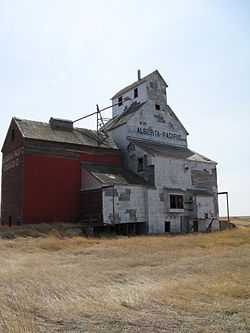
The Alberta Pacific Elevator at Raley was built as a 35,000-imperial-bushel (1,300 m3) elevator and is likely the oldest standing elevator in Alberta[1] constructed shortly after the St. Mary Railway line (succeed by Canadian Pacific Railway) was constructed in 1900 from Stirling to Cardston and finished in 1902. The elevator was built in 1905 by the Alberta Pacific Elevator Co. Ltd. A permanent cribbed annex was added to the elevator in 1940. In 1967 the elevator became part of the Federal Line of elevators. Then in 1972 the elevator was taken over by the Alberta Wheat Pool but was closed very shortly afterwards and taken over by the Hutterite colony at Raley. This elevator has high architectural significance as it is an excellent and the only unaltered example of an Alberta Pacific Elevator Co. 35,000-imperial-bushel (1,300 m3) capacity elevator.
The Alberta Pacific elevator at Raley was the first of a number of elevators operating by 1911. It is the only one that has survived, probably because it is now in private hands. By 1911 there were two other elevators at Raley, one was a 30,000-imperial-bushel (1,100 m3) elevator built by A.G. Robertson and the other a 15,000-imperial-bushel (550 m3) elevator operated by Sunny Belt Grain Elevator Co. Ltd. This was upgraded to a 30,000-imperial-bushel (1,100 m3) house in 1917. In 1924 the Raley Hutterite colony took over the A.G. Robertson elevator and in 1940 the Alberta Pacific Grain Co. took over the Sunny belt elevator, by this time owned by the N. Bawlf Grain Co. It was operated in conjunction with the original elevator. Both elevators went to the Alberta Wheat Pool in 1972. There was a fourth elevator at Raley, an Alberta Pool Elevator 40,000-imperial-bushel (1,500 m3) house built in 1929. This elevator disappears from the records by the late 1930s. The Sunny belt and A.g. Robertson elevators were demolished sometime after 1972.
Ellison Milling And Elevator Co.
(Stirling)
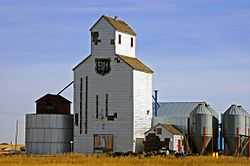
This 30,000-imperial-bushel (1,100 m3) metal-clad elevator was built by the Ellison And Elevator Co., in 1922. It was built at the railroad junction alongside the Ogilvie elevator built in 1910 by O.F. Ursenbach who was hired by George W. green, general manager. In 1941–1942 during the war years, a frame temporary annex was added to increase the handling to 60,000 imperial bushels (2,200 m3). In 1962 a bolted-steel tank was built to hold another 12,000 imperial bushels (440 m3) of grain increasing the capacity to 72,000 imperial bushels (2,600 m3). Parrish & Heimbecker bought the elevator in 1975. Later it was sold to a private owner who converted the elevator into a mustard plant. Today the elevator has once again been converted into a hemp plant, supplying hemp products around Southern Alberta and North America.
Ogilvie Flour Mills
(Wrentham)
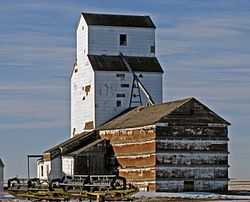
This 32,000-imperial-bushel (1,200 m3) elevator was built for Randell Gee & Mitchell in 1915. It was then sold to Midland Company Limited in 1919, and then to Ogilvie Flour Mills in 1921. Ogilvie built the balloon annex on the east side of the elevator in 1951. The elevator then closed in March 1959, and was sold to a local farmer (Wesley Kuehn) to use.
The elevator itself is still unchanged from its earlier years - the walkway that links the elevator to the office is one of two boxed walkways left in the province. The leg has a rope drive run by a four-cylinder Continental gasoline engine under the floor of the office.
Plans to salvage and save this elevator are still in the making. The Galt Historic Railway Park has shown interest in moving the elevator to preserve at their historic railway park in Stirling. Costs to move the elevator and annex is said to be $100,000.00.
Other Photos
-

Alberta Pool Elevator Co. elevator
-

Co-operative elevator twinned with an Alberta Wheat Pool elevator
References
- ↑ Alberta Pacific Elevator Co. Ltd. - Raley - Alberta Register of Historic Places - Alberta Heritage Survey Program